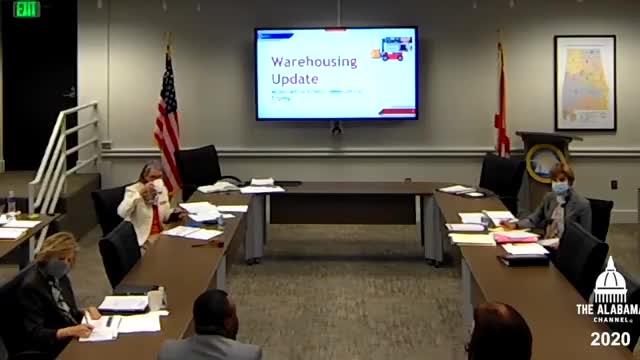State education department plans AMSTI warehouse accountability, eyes consolidation and funds teacher‑in‑residence pilots
October 15, 2025 | Alabama State Department of Education, State Agencies, Executive, Alabama
This article was created by AI summarizing key points discussed. AI makes mistakes, so for full details and context, please refer to the video of the full meeting. Please report any errors so we can fix them. Report an error »

At the work session the Alabama State Board of Education heard a multi‑part update on AMSTI (Alabama Math, Science and Technology Initiative) operations: new warehouse accountability measures, ideas for consolidation or efficiency gains, and the roll‑out of a teacher‑in‑residence (TIR) pilot funded with supplemental state dollars.
Warehouse accountability and efficiency: Department staff said they are implementing a tiered accountability model for AMSTI warehouse operations and partner university sites. Tier 1 is an immediate qualitative screening that checks whether a site meets AMSTI guidelines, with further tiers assessing industry best practices (including Lean Six Sigma principles), standardization of kit building and measurable productivity metrics. Staff said the goal is to reduce waste and surplus inventory so those savings can be redirected to instruction and regional specialists.
Consolidation discussion: Staff and board members discussed whether consolidating warehousing (fewer regional warehouses) could produce long‑term savings. Department staff said consolidation could yield savings but warned implementation would require analysis of leases, inventory management, and regional needs; the department said it will pursue cost‑benefit work and bring proposals to the board.
Teacher‑in‑Residence pilot: The department described a $2.7 million supplemental appropriation used to fund 27 teacher‑in‑residence positions initially and later expand to 31 TIRs in classrooms statewide for the school year. The TIRs are placed in schools identified as "limited support" (schools with math proficiency generally between 20% and 46% in 2019) and were funded to provide in‑school coaching. The TIRs are mentored by experienced AMSTI regional specialists; staff reported 62 schools and about 685 classrooms are being served by the initial deployment. The department plans to measure effectiveness through formative vendor pilots (for example, fluency programs implemented in pilot classrooms), early‑grade benchmark assessment vendors used statewide, and coaching logs that track student movement toward mastery during coaching cycles.
Why it matters: The warehouse reforms aim to reduce operational inefficiency so the department can reallocate resources toward direct instructional support. The TIR pilot is an early statewide effort to test school‑based coaching as a strategy to improve math outcomes in low‑performing schools.
Board next steps: Staff will produce site evaluation results and budget analyses for potential consolidation, and will report implementation and early outcome data from the TIR pilot in legislative reports beginning in February–March.
Ending: Board members expressed interest in both operational savings and measuring student impact from the TIR placements before expanding the model further.
Warehouse accountability and efficiency: Department staff said they are implementing a tiered accountability model for AMSTI warehouse operations and partner university sites. Tier 1 is an immediate qualitative screening that checks whether a site meets AMSTI guidelines, with further tiers assessing industry best practices (including Lean Six Sigma principles), standardization of kit building and measurable productivity metrics. Staff said the goal is to reduce waste and surplus inventory so those savings can be redirected to instruction and regional specialists.
Consolidation discussion: Staff and board members discussed whether consolidating warehousing (fewer regional warehouses) could produce long‑term savings. Department staff said consolidation could yield savings but warned implementation would require analysis of leases, inventory management, and regional needs; the department said it will pursue cost‑benefit work and bring proposals to the board.
Teacher‑in‑Residence pilot: The department described a $2.7 million supplemental appropriation used to fund 27 teacher‑in‑residence positions initially and later expand to 31 TIRs in classrooms statewide for the school year. The TIRs are placed in schools identified as "limited support" (schools with math proficiency generally between 20% and 46% in 2019) and were funded to provide in‑school coaching. The TIRs are mentored by experienced AMSTI regional specialists; staff reported 62 schools and about 685 classrooms are being served by the initial deployment. The department plans to measure effectiveness through formative vendor pilots (for example, fluency programs implemented in pilot classrooms), early‑grade benchmark assessment vendors used statewide, and coaching logs that track student movement toward mastery during coaching cycles.
Why it matters: The warehouse reforms aim to reduce operational inefficiency so the department can reallocate resources toward direct instructional support. The TIR pilot is an early statewide effort to test school‑based coaching as a strategy to improve math outcomes in low‑performing schools.
Board next steps: Staff will produce site evaluation results and budget analyses for potential consolidation, and will report implementation and early outcome data from the TIR pilot in legislative reports beginning in February–March.
Ending: Board members expressed interest in both operational savings and measuring student impact from the TIR placements before expanding the model further.
View full meeting
This article is based on a recent meeting—watch the full video and explore the complete transcript for deeper insights into the discussion.
View full meeting
